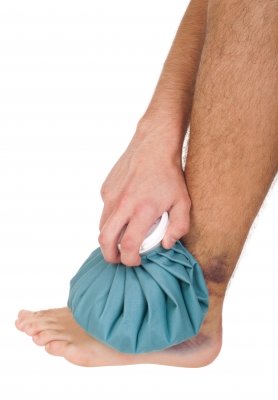Even while formal evaluation cannot be replaced, it's surprising how many conditions a few simple cares like hydrotherapy can benefit. Yet optimal health only comes when the needs of our whole being are met. While we often hear about physical and mental health, spiritual needs tend to be overlooked. This site takes its inspiration from the healing ministry of Christ, who cared for people in mind, body, and spirit. For more about how water provides symbolisms that explain his spiritual healing influence, or other spiritual questions, see this post at my other website, www.CosmoQuestions.com.
Ice Pack

Within the first 48 hours of injury an ice pack can reduce the swelling by causing injured blood vessels to constrict, thus preventing further leakage of blood into the surrounding tissues. They may also reduce pain by having analgesic effects on the nerves.
Effects / Benefits
Effective for acute injuries such as sprains or strains as part of “RICE” first aid therapy; “rest, ice, compression, elevation.”
Can also be useful for bruises, bleeding or pain related to recent injury- Slows and increases the force of the heartbeat. It is useful to use this when the heart rate becomes elevated above 100 related to taking a steam bath, for example (placing an ice pack over the heart).
Can help nose bleeds when placed over the bridge of the nose by causing the blood vessels of the nose to constrict. - May be useful for some types of headaches when placed on top of the head/hair and avoiding allowing the head to get too cold (which could cause rebound dilation of the blood vessels and increased headache).
May be beneficial for some conditions of chronic inflammation, such as tennis elbow.
Contraindications
Do not use on someone who is chilled, at risk for chilling or has strong aversion to the use of cold.
Do not use an ice pack without putting a layer (such as a hand towel) between the ice pack and the skin, or it could cause freezing and tissue damage.
Do not use an ice pack over an area of numbness or decreased neurological sensitivity.
Extreme caution should be used with anyone who has diabetic neuropathy (such as for a sprain or strain)- wrap with extra layers of a dry towel and consult a doctor.
Use extreme caution with anyone who has cognitive problems because they might not be able to tell you that it’s too cold or causing tissue damage.
Avoid using ice packs for sinusitis or pleurisy.
Discontinue using the cold compress if it causes discomfort or unpleasant symptoms.
Discontinue use if headache or Reynaud’s symptoms occur with use (Raynaud’s is a neurological condition resulting in constriction of peripheral blood vessels in response to cold- will cause white skin that tingles and is somewhat numb).
Equipment
Crushed or cubed ice, seal-able bag
Option: Gel Pack. Put 2 parts water to one part rubbing alcohol in a sealable freezer bag. Expel as much extra air as you can before sealing and then freeze (you can add blue food coloring if desired). You may want to double bag it to prevent leakage, or if you have some sort of vacuum sealer that would work even better. Of course, you could also purchase gel ice packs from the store.
Option: frozen peas or corn. This has often been considered an excellent ice pack because the peas will conform nicely to the shape of whatever you put them onto. Be sure to beat the bag when taking it out of the freezer, though, so that the peas or corn will be loose.
Face towel
Pillow case
Technique
If using crushed or cubed ice, put the ice into the plastic bag.
To avoid tissue injury, be sure to avoid direct contact with the ice pack. Wrap the ice pack in the face towel. You can also put it in a pillow case after that, so it won’t fall out of the towel. You may need to add more layers of towel at first if it’s too cold, or take some away as the ice warms up.
Lay the ice pack over the area to be treated. If it is for a recent injury, such as a strain or sprain, leave in on the area for about 15 minutes out of an hour as many times as you can for the first 48 hours, along with doing other “RICE” first aid measures.
If you are using the ice pack to decrease discomfort of a condition of chronic inflammation, leave it in place for only about 5-10 minutes.
It’s best not to go to sleep with the ice pack on, because it might get too cold and cause tissue injury or damage.
If you are putting the ice on someone who may not be reliable at noticing when it is too cold (such as someone elderly), it is best to check under the ice pack about every 5 minutes to make sure the skin is not too cold, bright red or white, which could indicate tissue damage.
References
Thrash, A, Thrash, C. Home Remedies. Seale: NewLifestyle Books; 2005, 70p.
Ice pack image courtesy of FreeDigitalPhotos.net